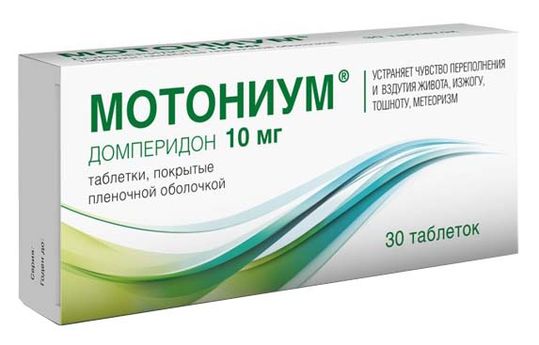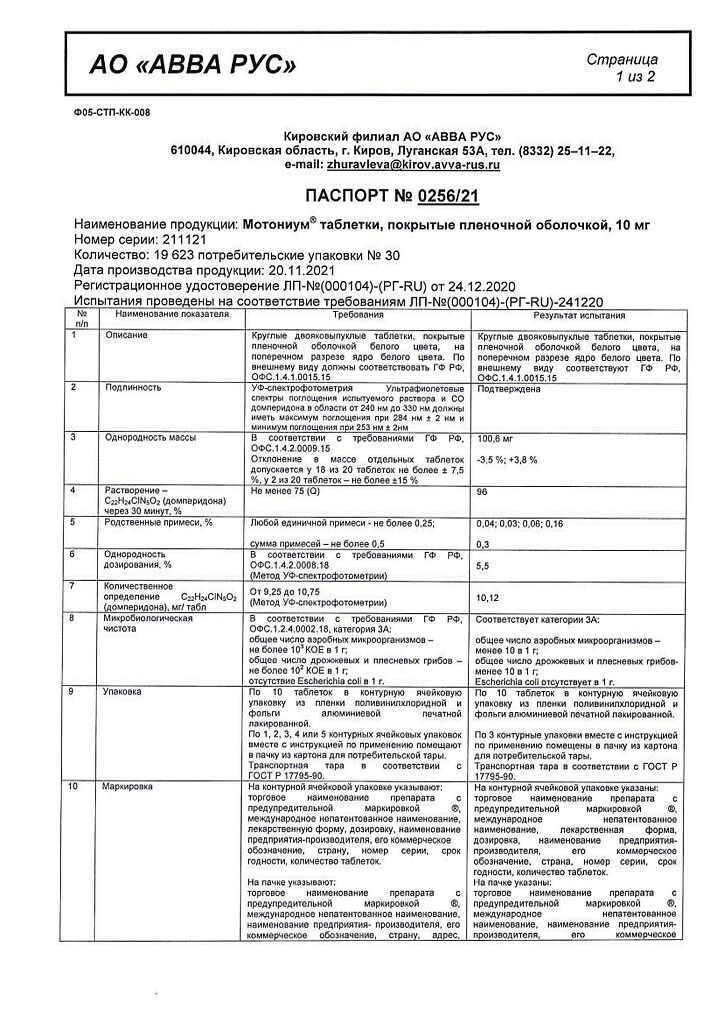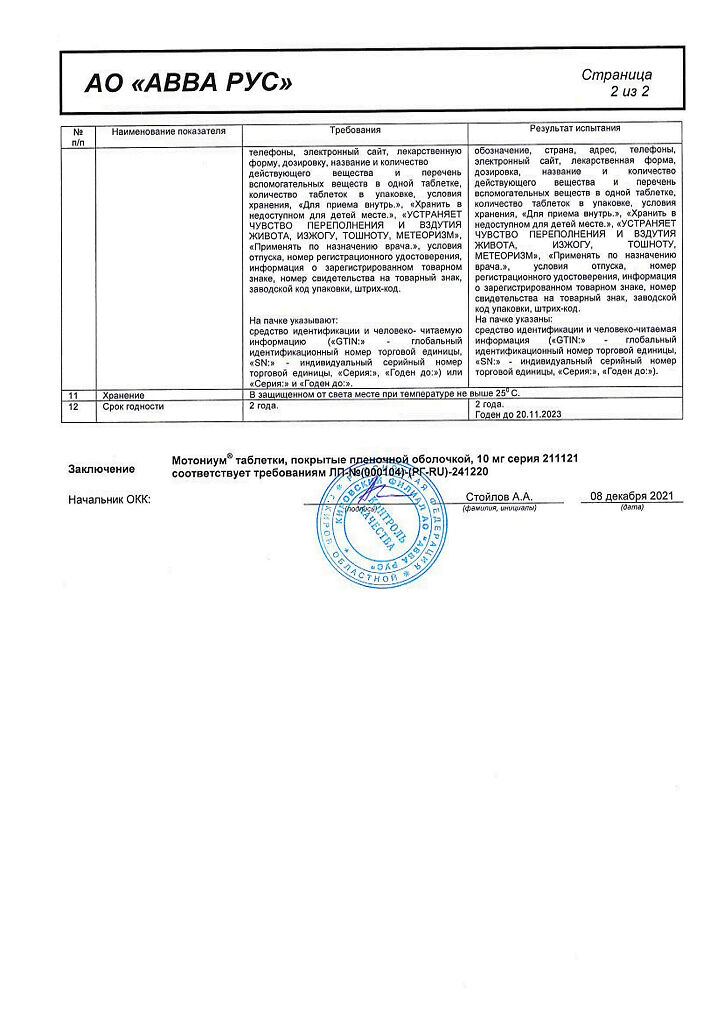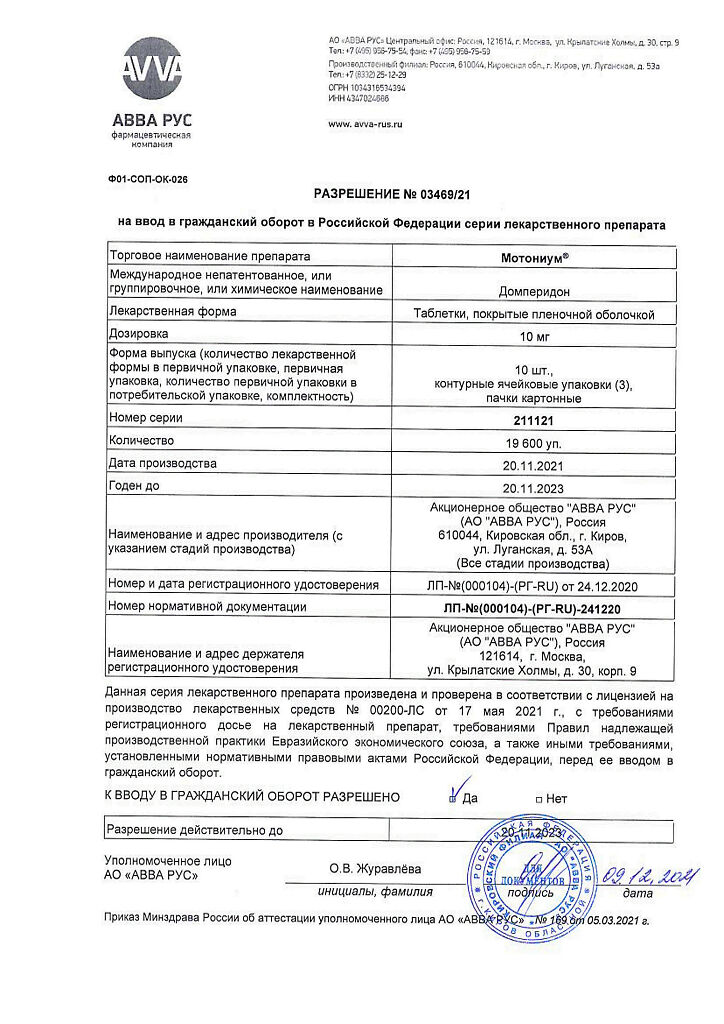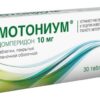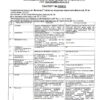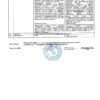No products in the cart.
Motonium, 10 mg 30 pcs.
€9.08 €7.94
Description
Motonium is a gastrointestinal normalizer and antiemetic.
Pharmacodynamics
It increases the duration of peristaltic contraction of the antrum of the stomach and duodenum, accelerates gastric emptying in case this process is delayed, increases the tone of the lower esophageal sphincter, eliminates the development of nausea and vomiting.
Stimulates release of prolactin from the pituitary gland. The antiemetic effect is probably due to a combination of peripheral (gastrokinetic) action and antagonism to dopamine receptors in the chemoreceptor trigger zone. Domperidone has no effect on gastric secretion.
Pharmacokinetics
After oral administration, the drug is rapidly absorbed. It has low bioavailability (about 15%). Cmax in plasma is reached after 1 hour. Decreased acidity of gastric contents decreases absorption of domperidone. It poorly penetrates through the HEB, so the use of domperidone is rarely accompanied by extrapyramidal side effects, especially in adults.
It is well distributed in various tissues; its concentration is low in brain tissues. Binding to plasma proteins is 91-93%.
It is subjected to intensive metabolism in the intestinal wall and the liver.
Extracted through the intestine (66%) and the kidneys (33%), in unchanged form, 10 and 1% of the dose value, respectively. T1/2 is 7-9 h, in severe renal insufficiency it is prolonged (see section “Precautions”).
Indications
Indications
A complex of dyspeptic symptoms associated with delayed gastric emptying, gastroesophageal reflux, esophagitis: a feeling of fullness in the epigastrium, a feeling of bloating, pain in the upper abdomen; belching, flatulence; heartburn with or without reflux of stomach contents into the oral cavity.
Nausea and vomiting of functional, organic, infectious origin, caused by radiotherapy, drug therapy or diet disorders, as well as against the background of dopamine agonists (for example, levodopa and bromocriptine), if used for Parkinson’s disease.
Pharmacological effect
Pharmacological effect
Motonium – normalizes the functions of the gastrointestinal tract, antiemetic.
Pharmacodynamics
Increases the duration of peristaltic contractions of the antrum of the stomach and duodenum, accelerates gastric emptying if this process slows down, increases the tone of the lower esophageal sphincter, and eliminates the development of nausea and vomiting.
Stimulates the release of prolactin from the pituitary gland. The antiemetic effect may be due to a combination of peripheral (gastrokinetic) action and antagonism of dopamine receptors in the chemoreceptor trigger zone. Domperidone has no effect on gastric secretion.
Pharmacokinetics
After taking the drug orally, it is quickly absorbed. It has low bioavailability (about 15%). Cmax in plasma is reached after 1 hour. Reduced acidity of gastric contents reduces the absorption of domperidone. It penetrates the blood-brain barrier poorly, so the use of domperidone is rarely accompanied by extrapyramidal side effects, especially in adults.
Well distributed in various tissues; in brain tissue its concentration is low. Plasma protein binding is 91–93%.
Subject to intensive metabolism in the intestinal wall and liver.
Excreted through the intestines (66%) and kidneys (33%), unchanged – 10 and 1% of the dose, respectively. T1/2 is 7–9 hours, with severe renal failure it is prolonged (see section “Precautions”).
Special instructions
Special instructions
In patients with severe renal failure (serum creatinine more than 6 mg/100 ml, i.e. more than 0.6 mmol/l), T1/2 increased from 7.4 to 20.8 hours, but plasma concentrations of the drug were lower than in healthy volunteers.
Due to the fact that a very small percentage of the drug is excreted unchanged by the kidneys, single dose adjustment is hardly necessary in patients with renal failure. However, when re-prescribed, the frequency of administration should be reduced to 1-2 times a day, depending on the degree of insufficiency.
It may also be necessary to reduce the dose. During long-term therapy, patients should be monitored regularly.
Active ingredient
Active ingredient
Domperidone
Composition
Composition
Active ingredient:
domperidone 10 mg;
Excipients:
lactose;
MCC;
cornstarch;
low molecular weight povidone,
glycerol;
magnesium stearate;
Shell: hydroxypropyl methylcellulose; polyethylene glycol 6000;
Pregnancy
Pregnancy
It can be used in the first trimester of pregnancy if the expected effect of therapy exceeds the potential risk to the fetus. Breastfeeding should be stopped during treatment (it is not known whether the drug has a negative effect on newborns).
When administered to animals in doses up to 160 mg/kg/day, domperidone did not have a teratogenic effect. To date, there is no evidence of an increased risk of developmental defects in humans. In women, concentrations of domperidone in breast milk are 4 times lower than the corresponding concentrations in plasma.
Contraindications
Contraindications
Hypersensitivity, gastrointestinal bleeding, mechanical intestinal obstruction, perforation of the stomach or intestines, prolactin-secreting tumor of the pituitary gland (prolactinoma), children under 5 years of age.
With caution: liver/renal failure.
Side Effects
Side Effects
From the digestive system: transient intestinal spasms.
From the nervous system: extrapyramidal disorders (in children and people with increased permeability of the BBB).
Allergic reactions: skin rash, urticaria.
Other: hyperprolactinemia (galactorrhea, gynecomastia).
Interaction
Interaction
Cimetidine, sodium bicarbonate, and other antacid and antisecretory drugs reduce the bioavailability of domperidone.
Anticholinergics counteract the effects of domperidone.
Azole antifungals, macrolide antibiotics, HIV protease inhibitors, and nefazodone increase plasma domperidone concentrations.
Overdose
Overdose
Symptoms: drowsiness, disorientation and extrapyramidal reactions (especially in children).
Treatment: administration of activated carbon, antihistamines; if extrapyramidal reactions occur, use anticholinergic antiparkinsonian drugs.
Storage conditions
Storage conditions
In a dry place, protected from light, at a temperature not exceeding 25 °C
Shelf life
Shelf life
2 years
Manufacturer
Manufacturer
ABVA RUS, Russia
Additional information
| Shelf life | 2 years |
|---|---|
| Conditions of storage | In a dry, light-protected place at a temperature not exceeding 25 °C |
| Manufacturer | Avva Rus, Russia |
| Medication form | pills |
| Brand | Avva Rus |
Related products
Buy Motonium, 10 mg 30 pcs. with delivery to USA, UK, Europe and over 120 other countries.

